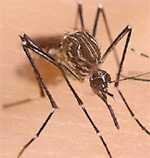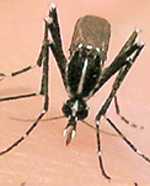Entomology & Ecology
Aedes aegypti, the principal mosquito vector of dengue viruses is an insect closely associated with humans and their dwellings. People not only provide the mosquitoes with blood meals but also water-holding containers in and around the home needed to complete their development. The mosquito lays her eggs on the sides of containers with water and eggs hatch into larvae after a rain or flooding. A larva changes into a pupa in about a week and into a mosquito in two days. See Aedes main aquatic habitats; from tree cavities to toilets and learn about the mosquitoes life cycle. People also furnish shelter as Ae. aegypti preferentially rests in darker cool areas, such as closets leading to their ability to bite indoors.
It is very difficult to control or eliminate Ae. aegypti mosquitoes because they have adaptations to the environment that make them highly resilient, or with the ability to rapidly bounce back to initial numbers after disturbances resulting from natural phenomena (e.g., droughts) or human interventions (e.g., control measures). One such adaptation is the ability of the eggs to withstand desiccation (drying) and to survive without water for several months on the inner walls of containers. For example, if we were to eliminate all larvae, pupae, and adult Ae. aegypti at once from a site, its population could recover two weeks later as a result of egg hatching following rainfall or the addition of water to containers harboring eggs.
It is likely that Ae.aegypti is continually responding or adapting to environmental change. For example, it was recently found that Ae. aegypti is able to undergo immature development in broken or open septic tanks [PDF – 1 page] in Puerto Rico, resulting in the production of hundreds or thousands of Ae.aegypti adults per day. In general, it is expected that control interventions will change the spatial and temporal dispersal of Ae. aegypti and perhaps the pattern of habitat utilization. For these reasons, entomological studies should be included to give support before and throughout vector control operations.

Aedes aegypti
Dengue viruses are mainly transmitted by the bite of infected Aedes aegypti mosquitoes; an invasive, domestic species with tropical and subtropical worldwide distribution that originated in Africa.

Aedes albopictus
Another important mosquito vector of dengue is Aedes albopictus, which is also an invasive species originally from Asia.
Fact Sheets
- Dengue and the Aedes aegypti mosquito [PDF – 2 pages]
- Dengue and the Aedes albopictus mosquito [PDF – 2 pages]
- Mosquito life cycle: English [PDF – 2 pages] | Español [PDF – 2 pages]
- Help Control Mosquitoes that Spread Dengue, Chikungunya, and Zika Viruses: English [PDF – 2 pages] | Español [PDF – 2 pages] | Português [PDF – 2 pages]
- For vector control programs: Controlling Aedes aegypti and Aedes albopictus [PDF – 2 pages]
- Page last reviewed: July 26, 2010
- Page last updated: April 5, 2016
- Content source:


 ShareCompartir
ShareCompartir